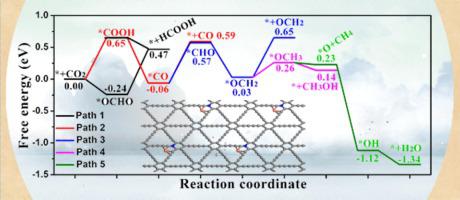当前位置:
X-MOL 学术
›
Appl. Surf. Sci.
›
论文详情
Our official English website, www.x-mol.net, welcomes your
feedback! (Note: you will need to create a separate account there.)
Theoretical investigation of CO2 electroreduction on N (B)-doped graphdiyne mononlayer supported single copper atom
Applied Surface Science ( IF 6.3 ) Pub Date : 2021-02-01 , DOI: 10.1016/j.apsusc.2020.148145 Zhen Feng , Yanan Tang , Yaqiang Ma , Yi Li , Yawei Dai , Hai Ding , Guang Su , Xianqi Dai
Applied Surface Science ( IF 6.3 ) Pub Date : 2021-02-01 , DOI: 10.1016/j.apsusc.2020.148145 Zhen Feng , Yanan Tang , Yaqiang Ma , Yi Li , Yawei Dai , Hai Ding , Guang Su , Xianqi Dai

|
Abstract Carbon dioxide electrochemical reduction reaction (CO2RR) with proton-electron pair delineates an intriguing prospect for converting CO2 to useful chemicals. However, CO2RR is urgently required low-cost and high efficient electrocatalysts to overcome the sluggish reaction kinetic and ultralow selectivity. Here by means of first-principle computations, the geometric constructions, electronic structures, and CO2RR catalytic performance of boron- and nitrogen-doped graphdiyne anchoring a single Cu atom (Cu@N-doped GDY and Cu@B-doped GDY) were systematically investigated. These eight Cu@doped GDY complexes possess excellent stability. The adsorption free energies showed that the eight Cu@doped GDY could spontaneously capture CO2 molecules. The Cu@N-doped GDY monolayers exhibit a more efficient catalytic performance for CO2 reduction compared to Cu@B-doped GDY because of the differences in adsorption energies and charge transfer. The calculations further indicated that the Cu@Nb-doped GDY complex possesses excellent catalytic character toward CO2RR with the same limiting potentials of −0.65 V for production of HCOOH, CO, OCH2, CH3OH, and CH4. Charge analysis indicated that the *OCHO and *COOH species gain more electrons from Cu@N-doped GDY than from Cu@B-doped GDY complexes due to different electronegativity of coordinated element. Our findings highlighted the electronegativity of coordinated elements for the design of atomic metal catalysts.
中文翻译:

N(B)掺杂石墨炔单层负载单铜原子上CO2电还原的理论研究
摘要 具有质子-电子对的二氧化碳电化学还原反应 (CO2RR) 描绘了将 CO2 转化为有用化学品的有趣前景。然而,CO2RR 迫切需要低成本和高效的电催化剂来克服反应动力学缓慢和超低选择性。在这里,通过第一性原理计算,系统地研究了锚定单个 Cu 原子的硼和氮掺杂石墨炔(Cu@N 掺杂 GDY 和 Cu@B 掺杂 GDY)的几何结构、电子结构和 CO2RR 催化性能调查。这八种 Cu@掺杂 GDY 配合物具有优异的稳定性。吸附自由能表明,八种 Cu@掺杂的 GDY 可以自发地捕获 CO2 分子。由于吸附能和电荷转移的差异,Cu@N 掺杂的 GDY 单层与 Cu@B 掺杂的 GDY 相比表现出更有效的 CO2 还原催化性能。计算进一步表明,Cu@Nb 掺杂的 GDY 配合物对 CO2RR 具有优异的催化特性,具有相同的 -0.65 V 生产 HCOOH、CO、OCH2、CH3OH 和 CH4 的极限电位。电荷分析表明,由于配位元素的电负性不同,*OCHO 和 *COOH 物种从 Cu@N 掺杂的 GDY 中获得的电子多于从 Cu@B 掺杂的 GDY 配合物中获得的电子。我们的研究结果强调了用于设计原子金属催化剂的配位元素的电负性。计算进一步表明,Cu@Nb 掺杂的 GDY 配合物对 CO2RR 具有优异的催化特性,具有相同的 -0.65 V 生产 HCOOH、CO、OCH2、CH3OH 和 CH4 的极限电位。电荷分析表明,由于配位元素的电负性不同,*OCHO 和 *COOH 物种从 Cu@N 掺杂的 GDY 中获得的电子多于从 Cu@B 掺杂的 GDY 配合物中获得的电子。我们的研究结果强调了用于设计原子金属催化剂的配位元素的电负性。计算进一步表明,Cu@Nb 掺杂的 GDY 配合物对 CO2RR 具有优异的催化特性,具有相同的 -0.65 V 生产 HCOOH、CO、OCH2、CH3OH 和 CH4 的极限电位。电荷分析表明,由于配位元素的电负性不同,*OCHO 和 *COOH 物种从 Cu@N 掺杂的 GDY 中获得的电子比从 Cu@B 掺杂的 GDY 配合物中获得的电子多。我们的研究结果强调了用于设计原子金属催化剂的配位元素的电负性。电荷分析表明,由于配位元素的电负性不同,*OCHO 和 *COOH 物种从 Cu@N 掺杂的 GDY 中获得的电子多于从 Cu@B 掺杂的 GDY 配合物中获得的电子。我们的研究结果强调了用于设计原子金属催化剂的配位元素的电负性。电荷分析表明,由于配位元素的电负性不同,*OCHO 和 *COOH 物种从 Cu@N 掺杂的 GDY 中获得的电子多于从 Cu@B 掺杂的 GDY 配合物中获得的电子。我们的研究结果强调了用于设计原子金属催化剂的配位元素的电负性。
更新日期:2021-02-01
中文翻译:

N(B)掺杂石墨炔单层负载单铜原子上CO2电还原的理论研究
摘要 具有质子-电子对的二氧化碳电化学还原反应 (CO2RR) 描绘了将 CO2 转化为有用化学品的有趣前景。然而,CO2RR 迫切需要低成本和高效的电催化剂来克服反应动力学缓慢和超低选择性。在这里,通过第一性原理计算,系统地研究了锚定单个 Cu 原子的硼和氮掺杂石墨炔(Cu@N 掺杂 GDY 和 Cu@B 掺杂 GDY)的几何结构、电子结构和 CO2RR 催化性能调查。这八种 Cu@掺杂 GDY 配合物具有优异的稳定性。吸附自由能表明,八种 Cu@掺杂的 GDY 可以自发地捕获 CO2 分子。由于吸附能和电荷转移的差异,Cu@N 掺杂的 GDY 单层与 Cu@B 掺杂的 GDY 相比表现出更有效的 CO2 还原催化性能。计算进一步表明,Cu@Nb 掺杂的 GDY 配合物对 CO2RR 具有优异的催化特性,具有相同的 -0.65 V 生产 HCOOH、CO、OCH2、CH3OH 和 CH4 的极限电位。电荷分析表明,由于配位元素的电负性不同,*OCHO 和 *COOH 物种从 Cu@N 掺杂的 GDY 中获得的电子多于从 Cu@B 掺杂的 GDY 配合物中获得的电子。我们的研究结果强调了用于设计原子金属催化剂的配位元素的电负性。计算进一步表明,Cu@Nb 掺杂的 GDY 配合物对 CO2RR 具有优异的催化特性,具有相同的 -0.65 V 生产 HCOOH、CO、OCH2、CH3OH 和 CH4 的极限电位。电荷分析表明,由于配位元素的电负性不同,*OCHO 和 *COOH 物种从 Cu@N 掺杂的 GDY 中获得的电子多于从 Cu@B 掺杂的 GDY 配合物中获得的电子。我们的研究结果强调了用于设计原子金属催化剂的配位元素的电负性。计算进一步表明,Cu@Nb 掺杂的 GDY 配合物对 CO2RR 具有优异的催化特性,具有相同的 -0.65 V 生产 HCOOH、CO、OCH2、CH3OH 和 CH4 的极限电位。电荷分析表明,由于配位元素的电负性不同,*OCHO 和 *COOH 物种从 Cu@N 掺杂的 GDY 中获得的电子比从 Cu@B 掺杂的 GDY 配合物中获得的电子多。我们的研究结果强调了用于设计原子金属催化剂的配位元素的电负性。电荷分析表明,由于配位元素的电负性不同,*OCHO 和 *COOH 物种从 Cu@N 掺杂的 GDY 中获得的电子多于从 Cu@B 掺杂的 GDY 配合物中获得的电子。我们的研究结果强调了用于设计原子金属催化剂的配位元素的电负性。电荷分析表明,由于配位元素的电负性不同,*OCHO 和 *COOH 物种从 Cu@N 掺杂的 GDY 中获得的电子多于从 Cu@B 掺杂的 GDY 配合物中获得的电子。我们的研究结果强调了用于设计原子金属催化剂的配位元素的电负性。









































 京公网安备 11010802027423号
京公网安备 11010802027423号